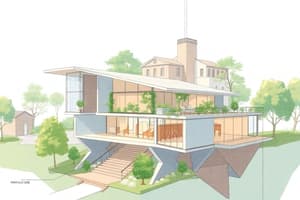Podcast
Questions and Answers
What is one of the primary responsibilities of the designer during construction?
What is one of the primary responsibilities of the designer during construction?
- To manage the financial aspects of the project
- To supervise the construction process (correct)
- To conduct market research
- To design furniture for office spaces
The designer should completely disengage from the project once construction begins.
The designer should completely disengage from the project once construction begins.
False (B)
What should have been part of the program from the beginning to ensure success?
What should have been part of the program from the beginning to ensure success?
Management support
The designer helps to ensure a smooth transition between construction and __________.
The designer helps to ensure a smooth transition between construction and __________.
Match the following responsibilities with the appropriate roles:
Match the following responsibilities with the appropriate roles:
What is the first step in the design process described?
What is the first step in the design process described?
The creative process of design is considered straightforward and predictable.
The creative process of design is considered straightforward and predictable.
What must the client do after receiving the cost estimates for the schematic plans?
What must the client do after receiving the cost estimates for the schematic plans?
The development of the project begins once the client has chosen a __________.
The development of the project begins once the client has chosen a __________.
Match the following stages of the design process to their descriptions:
Match the following stages of the design process to their descriptions:
Flashcards are hidden until you start studying
Study Notes
Schematic Plan
- The design process begins by defining the project's program and developing initial images and forms.
- This is a mysterious process that requires both a child-like openness to possibilities and a critical mind for analysis.
- The interaction between the designer and the evolving project is crucial, involving re-analysis of the site and users.
- Schematic plans showcase the building form, its location, exterior activity, circulation, and landscaping.
- Cost estimates are generated and presented to the client for approval.
- The client selects a plan, rejects all options, or requests changes.
- The chosen plan, based on anticipated future behavior, is finalized with its estimated cost.
Detailed Plan and Contract Documents
- After client approval, detailed development of the project occurs.
- This stage provides final cost estimates and allows for client approval.
- The detailed plan outlines building locations, roads, vegetation, and existing site information.
Methods and Processes
- Design supervision is crucial for ensuring construction compliance and making adjustments during the process.
- Plans are based on construction knowledge, accounting for machinery movement, material storage, site operations, and disruptions.
- The designer facilitates a smooth transition from construction to site management.
- Management support, a vital aspect of the project, is integrated from the start.
- Future managers are involved in the project's development, and the designer provides ongoing consultation.
The Art of Site Planning
- The site design process involves observing human interactions within the space to learn from mistakes.
- Designer involvement often lacks continuity, with transitions to use happening suddenly and limited information exchange.
- The site planning cycle consists of eight stages: defining the problem, programming & site & user analysis, schematic design, developed design, contract documents, bidding and contracting, construction, and occupation and management.
- The stages are not linear, creating a cyclical process where knowledge from later stages influences earlier ones.
- The plan is a learning experience, shaped by interaction between form, client needs, program, and the site.
- Ongoing feedback modifies the plan as the site's history and future occupants interact.
- The new site design is part of a continuous interplay between space and people.
- Another cycle of adaptation occurs as the site continues to evolve.
Environment and Quality of Life
- While physical settings are often considered a factor in the quality of life, this view requires careful examination.
- The relationship between physical settings and quality of life is complex and needs thorough consideration.
Studying That Suits You
Use AI to generate personalized quizzes and flashcards to suit your learning preferences.



